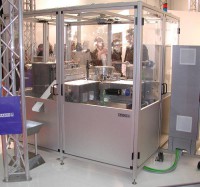Wilhelm Rasch/Schneider Electric
Consistent modularity for greater flexibility
Wilhelm Rasch GmbH & Co. KG surprised attendees at ProSweets Cologne 2013 with its introduction of a fully servo-driven confectionery packing machine. The machine’s impressive flexibility is the successful result of a modular design that incorporates mechanical aspects, electronics, and software. The company formed a project partnership with Schneider Electric to automate the machine with PacDrive 3.
Wilhelm Rasch GmbH & Co. KG surprised attendees at ProSweets Cologne 2013 with its introduction of a fully servo-driven confectionery packing machine. The machine’s impressive flexibility is the successful result of a modular design that incorporates mechanical aspects, electronics, and software. The company formed a project partnership with Schneider Electric to automate the machine with PacDrive 3.
At ProSweets 2013 in Cologne, Wilhelm Rasch introduced the first fully functional prototypes of its brand-new machine: The RU 2, designed as a universal machine, is operating at a speed of up to 160 units/minute. It can package anything that can be wrapped or folded in material with dimensions of 40 to 200 mm in width and length, including chocolate eggs, balls, and barrels, symmetrical and asymmetrical hollow figures, flat products, and bars.
In a demonstration at ProSweets, the machine packaged a hollow figure in aluminum foil with back folding. In this process, products are positioned in a synchronized circular plate, lifted through the wrapping foil by a lifter arm and clamped against a retaining piece, then placed into a rotating wheel with eight gripper arm assemblies. The foil needed for the packaging operation is unrolled from reels by tongs. Next, the machine performs a special Z-fold operation in several steps. Following this, products are run through a smoothing station.
Option design with short change-over times
Starting from this base version, the machine design can be expanded with optional modules for front folding, bottom folding, double twist, labeling, and even heat sealing for figures and pralines. A string attachment option is also currently in preparation. Thanks to quick-change devices for the modules and, where possible, design of the optional modules as a mono-block, the machine can be quickly retooled to handle different products. Retooling requires approximately one hour for a similar packaging type, and approximately four hours for a full change-over. Tina Gerfer, managing director of Wilhelm Rasch and granddaughter of the company’s founder notes that “these change-over times are a decisive improvement over the situation in traditional machines.” The new machine is fully servo-driven and uses a highly modular design that incorporates mechanical elements, software, and to the extent possible, even electronics. “We understand our business,” says Gerfer proudly, and also makes no secret of the fact that they brought a partner on board for the mechatronic part of the new machine. The European FlexCenter of Schneider Electric Machine Solution Services handled the implementation of the mechatronic project processes within the company as well as programming for the motion parts.
Cabinet-free automation wherever possible
A central PacDrive controller runs the machine and synchronizes all eight servo drives in the basic model. Two of these drives use a Lexium LXM62 double drive, one of the most compact cabinet-based servo systems available on the market. The remaining six servo axes are designed as integrated ILM62 servo modules, which are powered by the same shared power supply as the LXM62 controller.
Together with a networking solution based on pluggable hybrid cables and distributor boxes, ILM62 servo modules pave the way for cabinet-free automation and the design of consistently modular machines. Because the electronics of the servo drives are shifted into the machine modules, reconfiguration of the basic machine with additional or alternative optional modules doesn’t require any changes in the control cabinet. The controller program is based on the PacDrive template with its modular structures. Wilhelm Rasch installed the same full version of the program onto the controller of every machine it delivers. This means that every machine of this type is equipped to operate all of the currently available and planned option modules. Having this program installed simplifies version management during updates, and also allows every machine to accommodate additional options, even years later.
Autoconfiguration when switching modules
Each of the available optional modules can be activated automatically using autoconfiguration. All PacDrive motors and servo drives are equipped with electronic name plates. Following a change-over, the PacDrive controller performs a sercos scan, integrates all of the detected units into the current controller configuration, and activates the corresponding program modules.
These features now allow Wilhelm Rasch to offer its customers fully modular machines with outstanding flexibility. Despite the cutting-edge automation design, the company has still kept complexity to a minimum, as Tina Gerfer points out: “With this automation technology, even our new mechatronic machines remain true to our basic principles of providing our customers with robust machines that are easy to operate and maintain, and provide a long service life.” www.schneiderelectric.com

